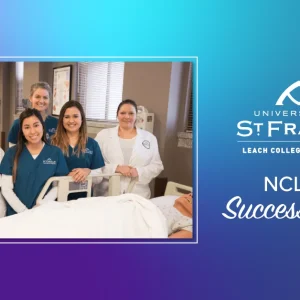Blended Learning: An Easy Way to Engage Your Nursing Students
Let’s face it: Keeping nursing students engaged requires more than just a traditional lecture. While this foundational teaching method has its place in education, today’s nursing students need more dynamic approaches to develop essential skills such as clinical judgment, decision-making, and reasoning.1 This is where blended learning comes in. This teaching strategy combines the best of both worlds by integrating traditional in-person instruction with digital tools and online resources.
Blended learning leverages the power of technology to create a more interactive and flexible learning environment.2 By incorporating multimedia resources, interactive activities, and online assessments, you can cater to different learning styles and keep your students engaged inside and outside the classroom. This approach enhances the learning experience and allows students to take greater control of their education, making them active participants in their learning journey.
The evolution toward blended learning has transformed the nursing curriculum, encouraging educators to adopt innovative strategies like the flipped classroom, where traditional lecture time is reimagined as interactive, student-centered learning. By using blended learning techniques, you can create a richer, more engaging educational experience that meets the needs of today’s nursing students.
The Flipped Classroom in Nursing Education: Past, Present and Future
The flipped classroom concept has gained traction in nursing education since the early 2000s, with its roots tracing back even further.2 Here’s a brief timeline of its evolution:
| 1993 | 1997 | 2000 | 2012 | |
| Alison King introduced the idea of a flipped classroom in her article, From Sage on the Stage to Guide on the Side, advocating for a more student-centered approach to learning.4 | Harvard University’s Eric Mazur developed peer instruction, a strategy where students take the lead in teaching the material, fostering a collaborative learning environment. | Wesley Baker coined the term “classroom flip,” emphasizing the importance of using technology to keep the factual and conceptual parts of lessons outside the classroom and reserving in-class time for active learning and peer interaction.5 | Maureen J. Lage and team further refined the flipped classroom model with their “inverted classroom” model, where students engage with pre-class materials such as readings and videos, allowing classroom time to focus on hands-on, interactive activities.6 | The flipped classroom gained momentum thanks to high school chemistry teachers Jon Bergmann and Aaron Sams, who revolutionized the approach by posting lectures online and using class time for deeper exploration of concepts.7 |
The Use and Impact of the Flipped Classroom in Nursing Education
Since 2007, nursing programs worldwide have adopted the flipped classroom and other blended learning methods, spurred by technological advances and the global shift toward online learning, especially during the COVID-19 pandemic. The unexpected shift to online learning also accelerated the movement toward hybrid or blended learning. This approach has proven to be highly effective in nursing education, offering several key benefits:3
- Improved academic performance
- Enhanced prioritization skills
- Stronger self-directed learning abilities
- Increased engagement and persistence
- Stronger sense of teamwork and collaboration
- Sharpened critical thinking and problem-solving skills
- Advanced test-taking strategies and clinical judgment
Adding UWorld Into the Flipped Classroom Design
So, what does this mean for you as a nursing educator?
While the benefits of the flipped classroom are clear, many educators find themselves overwhelmed by the prospect of redesigning their teaching strategies or simply don’t know where to start. That’s where UWorld comes in. Our online platform, evidence-based content, and interactive tools are flexible enough for face-to-face, hybrid, or online classes and designed to scale seamlessly with your nursing program, regardless of size.
There’s no need to reinvent the wheel with UWorld. You can focus on creating an enriching classroom experience and continue to be that essential guide on the side, equipping your students with the tools they need to succeed.
Here’s how UWorld can enhance your flipped classroom:
- Hundreds of concise lecture videos on high-yield topics
- Over 2,800 assignable practice questions, including 500+ NGN questions
- Detailed and concise answer explanations
- Digital learning tools, including flashcards and notebook
- Vivid medical images and illustrations
Need something more practical?
Wondering how to integrate UWorld into your flipped classroom? Here’s a simple breakdown:
| Flipped Classroom | Product | Examples | |
| Pre-Class Activities |
|
|
|
| In-Class Activities |
|
|
|
| Post-Class Activities |
|
|
|
Key Takeaways
- Engaging students in higher-order thinking is essential for modern nursing education.
- Technological advancements and blended learning are reshaping how nursing is taught.
- The flipped classroom improves academic performance, self-directed learning, critical thinking, and clinical judgment.
UWorld offers an easy integration into flipped classroom designs, providing high-quality, accessible resources that support student learning.
References
- Sullivan, K., Kolcun, K., & King, T. S. (2024). Classroom Innovation Using the NCJMM: Preparing Nursing Students for the Next Generation NCLEX. The Journal of Nursing Education, 63(3), 188–191. https://doi.org/10.3928/01484834-20240108-03
- Musni, S., & Garrett, B. (2021). Flipped Classroom Versus Classroom Lecture: A Content Mapping Study in Undergraduate Nursing. The Journal of Nursing Education, 60(11), 629–632. https://doi.org/10.3928/01484834-20210913-05
- Barranquero-Herbosa, M., Abajas-Bustillo, R., & Ortego-Maté, C. (2022). Effectiveness of flipped classroom in nursing education: A systematic review of systematic and integrative reviews. International Journal of Nursing Studies, 135, 104327. https://doi.org/10.1016/j.ijnurstu.2022.104327
- King, A. (1993). From Sage on the Stage to Guide on the Side. College Teaching, 41(1), 30–35. https://doi.org/10.1080/87567555.1993.9926781
- Baker, J. W. (2000). The “Classroom Flip”: Using web course management tools to become the guide by the side. Paper presented at the 11th International Conference on College Teaching and Learning, Jacksonville, FL.
- Lage, M. J., Platt, G. J., & Treglia, M. (2000). Inverting the Classroom: A Gateway to Creating an Inclusive Learning Environment. The Journal of Economic Education, 31(1), 30–43. https://doi.org/10.2307/1183338
- Bergmann, J., & Sams, A. (2012). Flip your classroom: Reach every student in every class every day. Oregon, Washington: ISTE.





